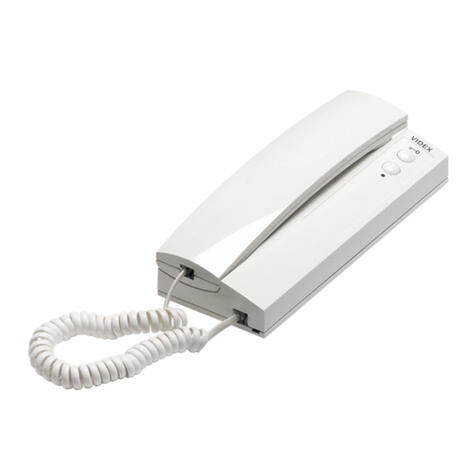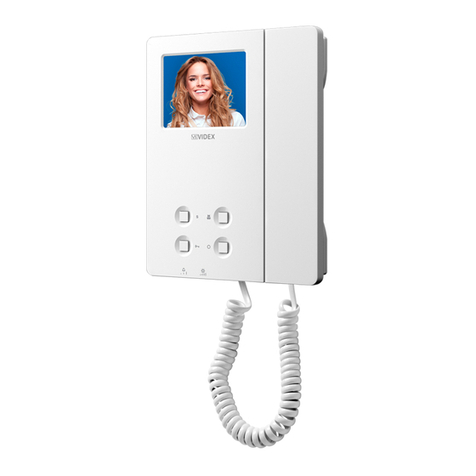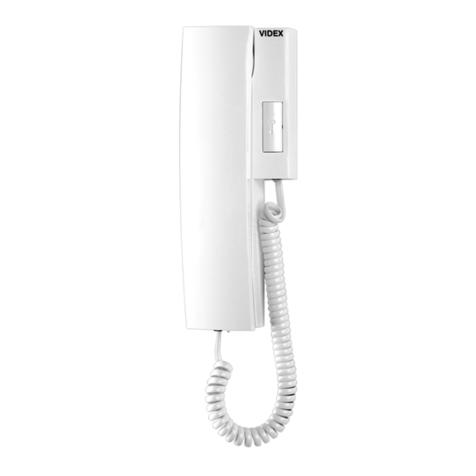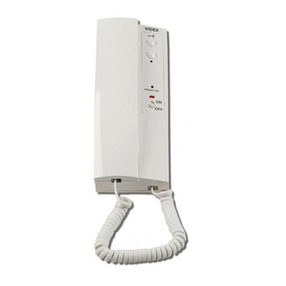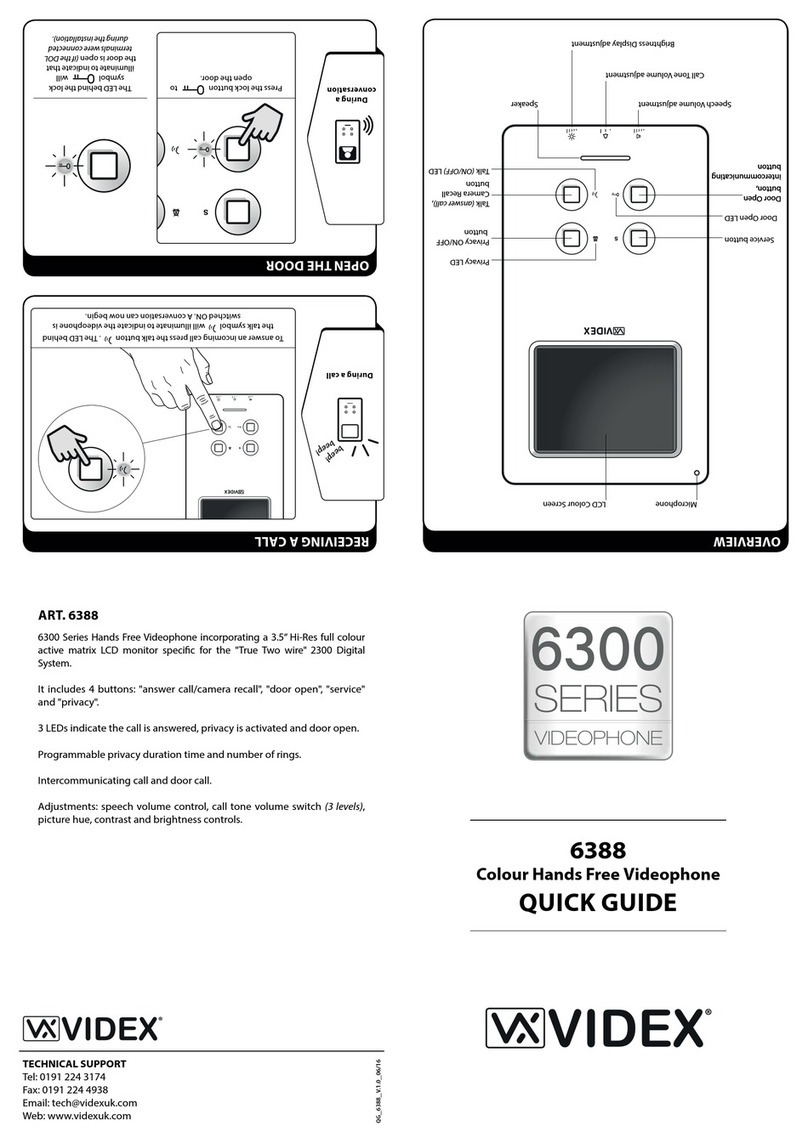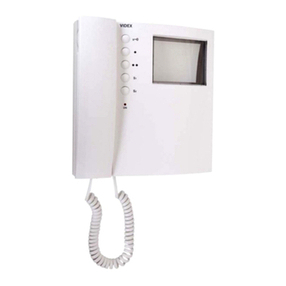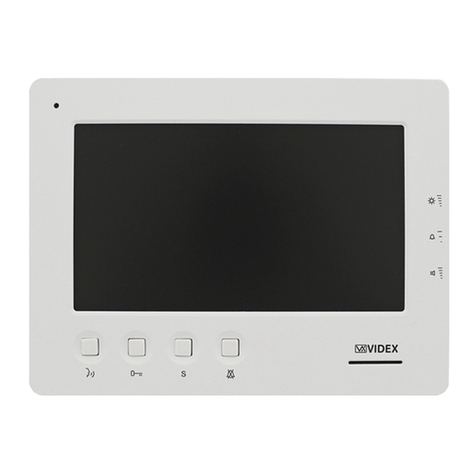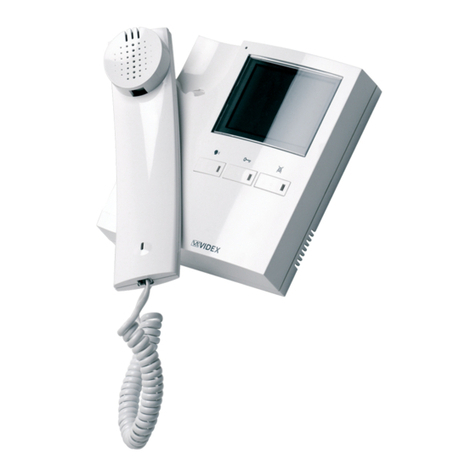Two Wire Videokit ESVK Series
PrtCode:66550045EN.doc – Pag.6/6 15/02/2013 Rev.1.0
Art.KRV88/KRV86 Kristallo videophones
112 42
155
182
29 120
190
839
189
119
29
KRV88KRV86
AL
LB
LB_AL
DOL
NO
C
+30VAUX
GND
+12Vaux
GND
BUS
BUS
BUS TERMINATION
ON ON
SW3 SW1
Fig.1
DESCRIPTION
Intelligent Hands free video monitor for the VX2300 digital system using 3,5” OSD full colour active matrix LCD monitor, with touch sensitive buttons for
“door open / service” , “answer/camera recall”, “privacy / bus relay” plus 5 navigation menu buttons and 3 LEDs related to the videophone operation. For
the surface version only (Art.KRV76), a handset can also be used in addition to the hands free mode. Additional features include a real time clock, a
temperature sensor and a serial RS232 port for future integration with home automation systems.
PUSH BUTTONS, LEDS AND CONTROLS (FIG.1)
Answer Button - Press this button during an incoming call to open the speech in duplex mode allowing free speech with the caller in
both directions (The related LED will illuminate).
Camera Recall Button - When the system is in standby, (No calls on the system) operation of this button will open the speech to the
door station. The related LED will illuminate. Press as many time as the ID value of the door panel to connect to.
End Conversation Button - During a conversation, momentary operation of this button will end the call. The LED next to the button will
switch off. The system will automatically switch off when the conversation time expires.
PTT Enable Button - Press and hold this button (more than 1 second), during an incoming call or a conversation in progress, to allow
the user to answer a call from a visitor at the door station in SIMPLEX speech mode (The related LED will flash rapidly): releasing the
button will allow the user to listen to the visitor (The LED will flash slowly). Press and hold the button when you talk to the visitor and
release the button when you listen to the visitor.
Door Open Button - During a conversation, momentary operation of this button will release the door from where the call originated.
This will be confirmed by an acoustic tone and the key icon on the top of the screen under the date, time & temperature row. If terminal
“DOL” is connected, the “door open” LED next to the button will also be illuminated.
Aux Service Button - During a conversation, keep pressed this button to enable the auxiliary service relay. This will be confirmed by a
message on the display: terminals “C” and “NO” are internally linked until the button is released.
Intercommunicating call button - For an intercommunicating call, when the intercom is in stand-by, press as many times as the ex-
tension number (intercommunication among the apartment units) or address value to call (intercommunication among all the units of
different apartments). For videophones with handset the intercommunication can be hands free or conventional by picking up the hand-
set before calling.
Privacy Button - When the system is in stand-by, press this button to enable the service for the programmed time: the related LED will
illuminate to signal the service enabled. During an incoming call, with the service enabled, the device does not emit any acoustic signal.
The service is disabled when the programmed time expires or pressing again the button.
Programming Menu Button - With the system in stand-by, keep pressed this button until the monitor switches on showing the pro-
gramming menu where you can set date & time, privacy duration, call tone volume, melody and number of rings. Once the menu is en-
abled, proceed with settings by the menu navigation buttons.
Call Reject Button - During an incoming call, press this button to reject the call. The visitor doesn’t receive any warning of the call re-
jected.
Adjustment Menu Button - During a conversation, press this button to enter a programming menu that allows to set speech volume,
picture brightness, contrast and hue. Once the menu is enabled, proceed with settings by the menu navigation buttons.
Bus Relay Button - During a conversation, keep pressed this button until the display shows a yellow band at the bottom side. Select
the BUS Relay to enable by the buttons “Plus” and “Minus” then press OK to enable the relay.
Menu navigation buttons – these buttons to be used during adjustment and programming menus. Via these buttons you can set the
date & time, the melody, the number of rings and the privacy duration and you can adjust the speech and call tone volume and the pic-
ture brightness, contrast and hue. Use top & down arrow to move along settings, plus and minus to alter settings and OK button to
confirm.
Camera switch button - If the door station uses the Art.4303N plus the Art.4330N, pressing this button during a conversation switches


